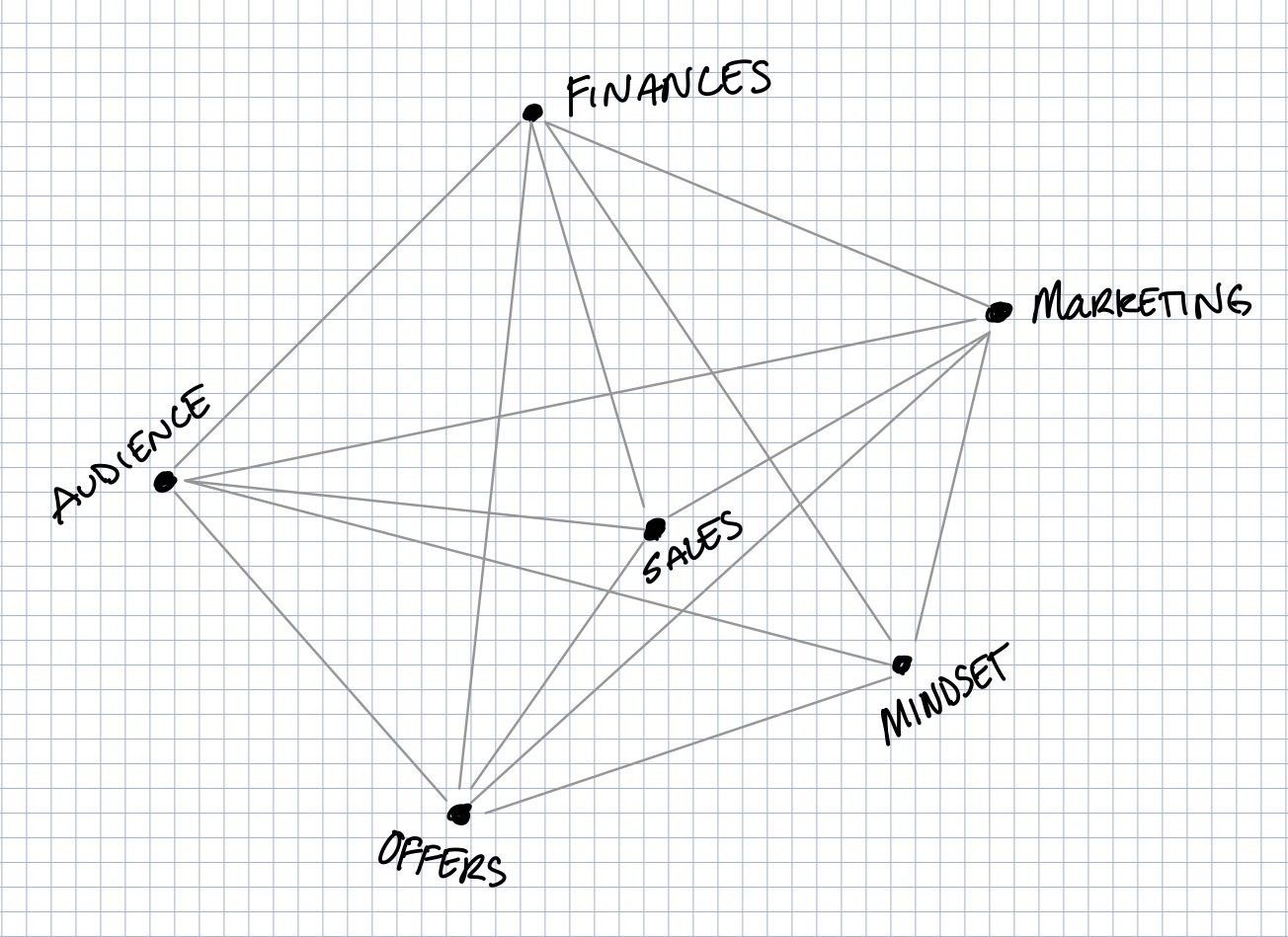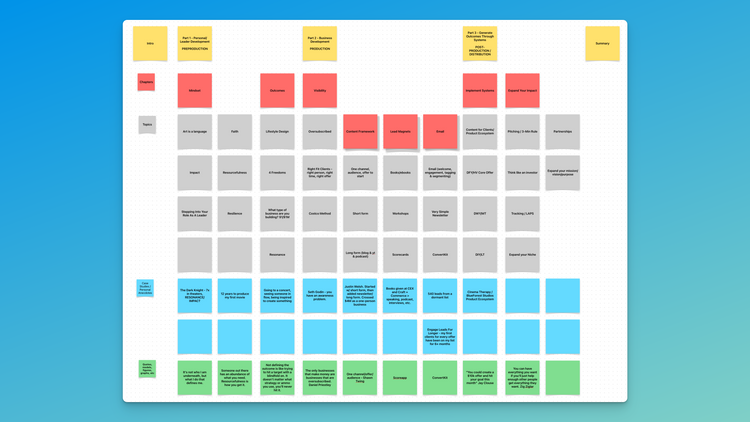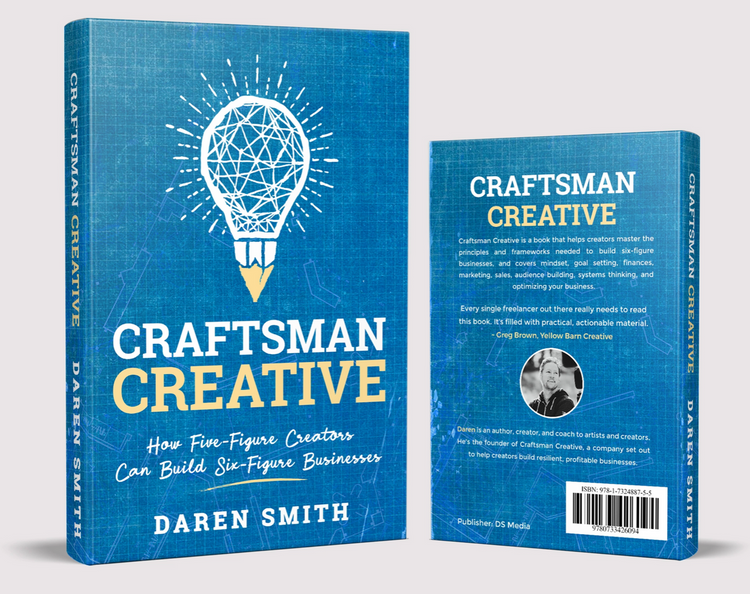Systems Thinking For Creatives

This topic has been a rabbit hole for me for a few years now.
The idea originally surfaced when I read Thinking in Systems by Donella Meadows. It's a transformational book that I believe Seth Godin or André Chaperon recommended a few years ago.
Since then I've read other books and blogs and watched videos about systems thinking and now feel that this concept is one of the most powerful principles I could share with those that I get the chance to work with.
This chapter has taken the longest to write since I have so many notes from so many places that there was a lot more time to organize my thoughts and get this out.
By the end of this chapter, you'll see your business in a whole new way, and will change your approach to growing your business and see results like you never have before. Once you understand how to see your business as a system, you'll never be able to go back.
Defining A System
From "Thinking in Systems"
A system is a set of things—people, cells, molecules, or whatever—interconnected in such a way that they produce their own pattern of behavior over time.
In this book, we've covered different parts of your business - finances, marketing, audience building, sales, offers, and your mindset as the business owner.
It would be easy to see them as separate, independent parts. For example, if you want to grow your audience more, focus on growing your audience.
But in reality, these different parts of your business are interconnected in a way that any change or improvement to one part has an effect on the other, connected parts of your business.
When you improve your offer, your audience grows, which impacts your sales and revenue and helps you see yourself as a successful business owner.
These different parts of your business aren't siloed. They are interconnected, and that interconnectedness is what produces the outcomes for your business.
The shift to make is one of linear thinking to non-linear thinking.
Rather than marketing > audience > offer > sales > revenue, a linear view of your business and its different parts, it looks more like this:

Every part of your business has a connection and a relationship to the other parts.
What you do in one area of your business has an effect on the other areas.
Boy, I wish I knew this years ago...
The Problem With Linear Thinking
When I ran a video production company, arguably my greatest failure was my linear thinking.
I, wrongfully, thought that every part of the business would operate in it's own "box", so if money was tight I would go and book more work. If we had too much work I would jump in and help with the editing. When those projects were done, I'd go and find more.
It was a very reactionary way of operating, and it served us poorly.
The failure to see the business as a system rather than just a "sum of it's parts" led to burnout and nearly bankrupted us.
I would book $100k worth of projects at the beginning of the year. Then we would rush to service all of those clients, often missing deadlines or having a project fall through. That $100k would turn into only $30-40k worth of revenue, which was only enough for 2-3 months.
But because we'd booked the work I was too busy helping in post-production to go out and find new work. So that 2-3 months of revenue would have to stretch to four, five, even six.
And then if a client didn't pay on time, we were really hosed.
As soon as I was free to go get more work I'd go and book a bunch of new clients, but those new clients wouldn't start for weeks or months, which means the money from those projects wasn't coming any time soon either.
Outside of all this, I wasn't paying enough attention to my business partner and what he was going through.
This linear thinking and reactionary way of running a business ended in me going $15k in debt to try and keep the business afloat - another linear decision.
We were out of money, we needed to float a month or two of payroll before our next projects came in, so I took on debt to pay our salaries.
But then, those projects never panned out. We found ourselves at the end of the year with no clients, no projects, no revenue, and no business.
I left that business in 2017 and vowed to figure out what went wrong so I never repeated it again.
Fast forward four years and systems thinking is one thing that could have saved us, had I known how to operate with that framework back then.
Optimizing Linearly Can Hurt Your Business
The key takeaway from that story is that linear thinking can not only not work, but could also actively hurt your business.
Take the idea of a sales funnel that I wrote about in the last section of the book.
Most people would agree that getting more people through a sales funnel would be good for a business.
So they optimize that funnel for a singular outcome - more customers.
However, because of their linear thinking, they end up hurting the business.
More customers aren't always good. If you acquire your new customers at a loss, hoping to make an upsell to a percentage of the new customers your funnel has generated, more customers could mean more expense. How long can you sustain a loss?
If you have shipping involved with your business but are acquiring a lot of small sale customers, you might lose money from the shipping, or from paying for returns.
More customers aren't always the right answer for a business.
More of the right customers, happy customers, on the other hand, is what businesses need to optimize for.
But to do so you have to understand the relationship between your marketing, your offer, your sales, and your audience so that you only attract the right people who can afford what you're selling as well as see the value in it.
That's a completely different approach. One that takes into account how all of the different parts of your business.
Had I done this with my last business, I would have never stopped finding new clients. I would have created a system to generate new leads and new projects every week, because if the projects stop coming in, so does the revenue.
Had I known that our mindset as business partners was so essential to the success of the business, I would have set aside more time for conversation and rest so that we didn't get burnt out.
I never would have taken on debt but would have found other ways to optimize the business to be profitable and more sustainable.
But all of those actions require a different perspective.
The Emergent Quality Of A System
A system is a set of inputs and outputs that, when operating properly, create an outcome.
A simple example is a bathtub. You've got water from a faucet pouring into a tub, and a drain that allows that water to run out of the tub.
You can add more parts, like a temperature knob to control the temperature of the water.
You could use a thicker or different material for the tub so that the water inside holds its temperature for longer.
You can improve the stopper in the drain so that less water leaks out.
When all of these parts work together as an optimized system, the emergent quality is a nice hot bath that lasts for a long time.
In a previous chapter, I talked about creating "happy customers". That's the emergent quality that I want for my businesses. I know that if happy customers are emerging from the system that is my business, then the system is operating how I want it to.
If, on the other hand, I'm getting a lot of mean or confusing comments to my writing, or am not seeing any sales of my products, or my audience isn't growing, or my revenue isn't growing, then I know that the system isn't working how it should.
At that point, because the emergent quality isn't present, I can dive into the system and experiment to see which part I need to focus on in order to have that emergent quality appear.
In order to start thinking in systems for your business, you need two things:
- An understanding of the emergent qualities your system should create
- An understanding of the different parts of your system and their relationship to each other
When you start to see your business this way, as a system, you start thinking more like a business owner than a creator with a lot of different jobs.
You can spend time working on your business, rather than in your business.
You can optimize the system to get the emergent qualities that you care about, whether that's happy customers, more revenue, more freedom and independence, or more impact.
Don't just run from fire to fire in your business, addressing things when it's too late.
Take a step back, see your business as the system that it is, learn to understand the relationships between the different parts, then ask yourself how you can tweak and optimize the system to be better at generating the outcomes that you care about most.
NEXT CHAPTER >

< PREVIOUS CHAPTER








Member discussion